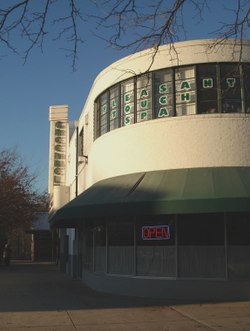Greenbelt Historic District (Greenbelt, Maryland)
|
Greenbelt Historic District
|
|
 |
|
| Location | Greenbelt, Maryland |
|---|---|
| Coordinates | 39°0′10″N 76°53′28″W / 39.00278°N 76.89111°WCoordinates: 39°0′10″N 76°53′28″W / 39.00278°N 76.89111°W |
| Built | 1935 |
| Architect | Walker, Hale; Wadsworth, Reginald |
| Architectural style | Other |
| NRHP reference # | 80004331 |
| Significant dates | |
| Added to NRHP | November 25, 1980 |
| Designated NHLD | February 18, 1997 |
The Greenbelt Historic District is a national historic district located in Greenbelt, Prince George's County, Maryland, United States. The district preserves the center of one of the few examples of the Garden City Movement in the United States. With its sister cities of Greenhills, Ohio and Greendale, Wisconsin, Greenbelt was intended to be a "new town" that would start with a clean slate to do away with problems of urbanism in favor of a suburban ideal. Along with the never-commenced town of Greenbrook, New Jersey, the new towns were part of the New Deal public works programs.
Greenbelt's center has survived with few alterations compared with its sister towns. It was designated a National Historic Landmark in 1997.
In April 1935 Congress passed the Emergency Relief Appropriation Act, intended to counter the effects of the Great Depression through the appropriation of $5 billion for jobs programs. As a result, President Franklin Delano Roosevelt established the Resettlement Administration (RA) to coordinate federal efforts concerning housing and land, placing particular emphasis on rural poverty. While the focus of the RA remained primarily rural, it was also charged with resettling farm workers who were leaving agriculture in search of industrial work. New towns were seen as a solution to this problem, to be built outside urban areas and surrounded by healthful green belts of preserved land. As many as 3000 of these towns were initially envisioned. 100 cities were studied for new towns, eventually narrowing to 25. Four sites were picked for the first trials: Washington, D.C, Milwaukee, Wisconsin, Cincinnati, Ohio and New Brunswick, New Jersey. The Washington site was to be near Berwyn, Maryland, on land depleted by tobacco farming. 12,000 acres (49 km2) were purchased, and work began in late 1935, using 1000 laborers.
...
Wikipedia


